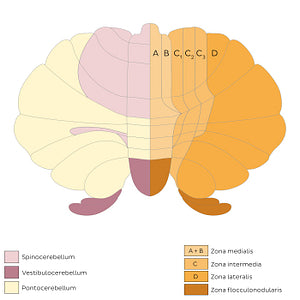Paul Kim
Cerebellum - divisions and zones (schematic) (Latin)
Cerebellum - divisions and zones (schematic) (Latin)
Afferent connections of the cortex cerebelli can be described according to three regions:- the spinocerebellum (receives somatosensory input from the medulla spinalis) which functions to modify descending motor commands in order to regulate movement, maintain balance, and control posture,- the pontocerebellum (a.k.a. cerebrocerebellum, receives afferent fibers from the cerebrum via the nuclei pontis) which is thought to be involved in the planning and initiation of voluntary movements,- the vestibulocerebellum (receives vestibular and visual information) which is responsible for regulation of balance/vestibular reflexes and eye movements. Efferent, or corticonuclear connections can be described according to four bilateral zonae longitudinales: zona medialis (vermalis), zona intermedia (paravermalis), zona lateralis and zona flocculonodularis. Each zone projects to either one of the nuclei cerebelli (discussed in the next study unit) or the nuclei vestibulares in the brainstem. The zona medialis is subdivided into two zones, A and B. The zona intermedia is subdivided into three zonae (C1, C2, and C3), while the zona lateralis is also known as Zona D.
Normaler Preis
$7.56 USD
Normaler Preis
Verkaufspreis
$7.56 USD
Grundpreis
pro
Verfügbarkeit für Abholungen konnte nicht geladen werden


#F6A732
#A26C6B
#CB7314
#716453
#FFD477 und #D6CAB5

